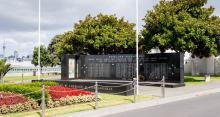Able Seaman Henry John ‘Jack’ Kindred, (“…lost at sea 1941 aged 22 years..” is inscribed on parents’ grave at Mangere Lawn Cemetery) parents were Percy Thomas Kindred [1886-1946] and Marian Violet Kindred [ 1888-1967] of Torbay, Auckland. CWGC does not mention he was on ML311). However, in the report by Lt Cmdr. Campey, RANVR, he specifically lists Henry Kindred as a crew member of ML311 although states his fate as ‘Unknown’ and a file in the UK Archives records ‘J. Kindred, AB, RNZNVR’ as ‘Missing Believed Killed or Drowned’ aboard ML311.The Royal New Zealand Navy Museum records are “ … Kindred, Henry , Able Seaman, RNZN 3739, - Most likely killed on 15 February 1942 near Muntok, Banka island, Sumatra while serving on ML311 [ML310] when fleeing Singapore. Possibly died of disease when ashore with other survivors. Age 22 from Torbay, Auckland- declared dead & on memorial…”. Research into the fate of HMML 311 near the mouth of the Musi River in south Sumatra includes the following description of the vessel and those on board as the Japanese warships fired on it ”… The horrific situation of high explosive shells and heavy machine gun bullets (referred to by Clark as ‘shorts’) literally smashing the wooden hull, decks and superstructure of ML311 and at the same time the bodies of some fifty or more men on the decks and engine room, within the space of probably ten minutes, must have traumatised any survivors. The reality is that five of the thirteen naval ratings on the ML311 and probably some forty to fifty ( of the 57 ) British Army personnel standing on the vessels deck lost their lives within minutes of the Japanese attack; with the probability that another five or six of the survivors - out of Lt Cdr Clark’s description of “…. barely twenty men, including wounded, took to the water …” – were soon dying from their wounds, lack of fresh water or shark attacks in the Banka Strait after the sinking. Major Lyddon gives in his narrative an indication of survivors at that stage when he tells us “… There were about 30 in the water most of whom swam to the BANKA shore. Pte. Simpson and I made up a small raft. There was a strong current to the south and after swimming for about 10 hours we reached a fishing pagar 15 to 20 miles from where the ship was sunk. It was then about 1630 hrs, 15 February. During the morning of the 16th February Lt. Commander Clark swam up to our Pagar from another further up the coast. He was wounded by shrapnel in the left forearm. At about 1200 hrs the three of us swam the 500 yards to the shore and then travelled about 6 to 7 hours through the mangrove swamps, arriving at dusk at a river SUNGEI POELURAN REDDING. We could see lights and after swimming to them found a fishing village where we were given food and a place to sleep. On 17th February Major Bird R/A aged 41 joined us. He was from HMML 433 and had left 3 or 4 others south of the kampong where we were staying…”. Cmdr. Reid states that there were an estimated 14 survivors – Lyddon’s report describes 8 of them..
[Michael Pether, New Zealanders who died in Second World War- Singapore, Malaya, Dutch East Indies, and Burma/Thailand]


